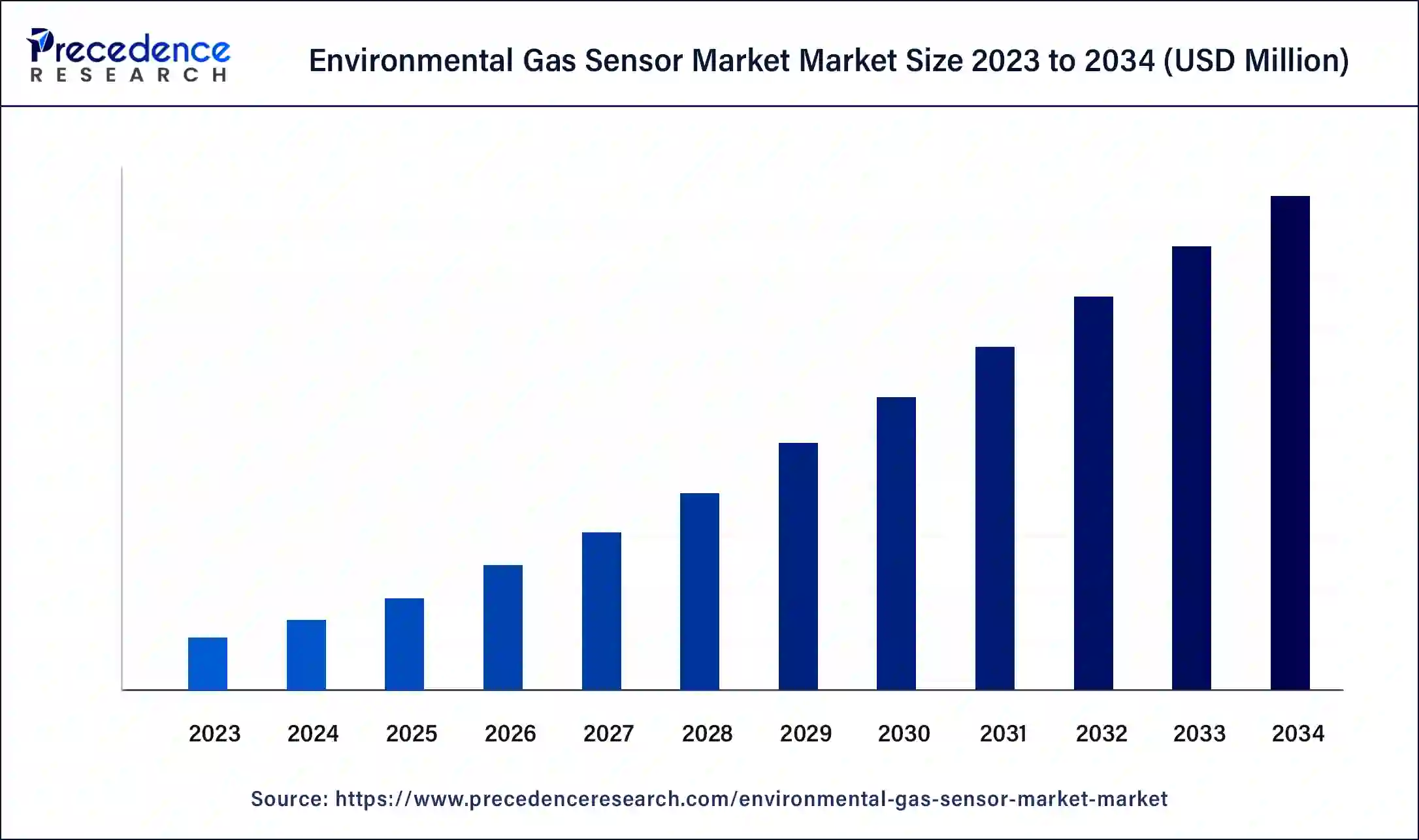February 2025
Environmental Gas Sensor Market - Global Industry Analysis, Size, Share, Growth, Trends, Regional Outlook, and Forecast 2024-2034
The global environmental gas sensor market is fueled by increasing pollution awareness and tech innovations. From 2024 to 2034, the market is evolving, with Asia-Pacific leading and North America experiencing rapid growth in air quality monitoring and smart city projects. The environmental gas sensor market is driven by rising anxiety over pollution in the environment and air quality. These sensors are essential for keeping an eye on different areas to make sure rules are followed and public health is safeguarded.

The industrial segment devoted to creating, manufacturing, and distributing sensors intended to identify and gauge the concentration of different gases in the environment is known as the environmental gas sensor market. These sensors provide information on pollutants like carbon dioxide, carbon monoxide, nitrogen oxides, methane, sulfur dioxide, and volatile organic compounds. They are also used to measure emissions, monitor air quality, and detect gas leaks. Gas sensors play a vital role in industrial environments by identifying leaks and averting mishaps, explosions, and fires. This guarantees infrastructural and worker safety by delivering real-time data on air quality, integrating gas sensors into the Internet of Things (IoT) infrastructure, and implementing smart city projects to improve urban living. To raise everyone's standard of living, this data can be utilized to make well-informed judgments on industrial operations, traffic control, and urban development.
To manage air quality and make individual exposure-reduction decisions, air quality data are crucial for monitoring air pollution levels over time and space. Numerous studies conducted over the years have demonstrated that being exposed to air pollution raises the quantity and severity of health issues. For instance, premature mortality, some malignancies, and adverse effects on the cardiovascular and pulmonary systems have all been related to particulate matter air pollution exposure.
| Report Coverage | Details |
| Largest Market | North America |
| Quantitative Units | Revenue in USD Million/Billions, Volume in Tons, CAGR from 2024 to 2033 |
| Base Year | 2023 |
| Forecast Period | 2024 to 2034 |
| Regions Covered | North America, Europe, Asia-Pacific, Latin America, and Middle East & Africa |
How Asian Countries Promote the Application of Environmental Gas Sensors?
As people become more conscious of how air pollution affects their health, there is a greater need for air quality monitoring equipment. People are more aware of their air quality and are looking for ways to improve it. The region's economic expansion has made investing more in environmental technologies possible. Both public and commercial sectors can more extensively invest in superior gas sensor technology.
Considering leading instances, Japanese automotive manufacturers are using gas sensors to monitor and reduce vehicle emissions, aligning with the country’s commitment to lowering greenhouse gas emissions and combating climate change. Tokyo has deployed a network of environmental gas sensors to monitor industrial emissions and ensure compliance with stringent air quality standards. These sensors detect gases such as NOx, SOx, and VOCs, helping to reduce industrial pollution.
How Technological Advancements Help Gas Sensor Industry in North America to Grow?
Governments and the public are becoming more conscious of the negative effects that poor air quality has on health. Rising investments in air quality infrastructure are fueling the need for environmental gas sensors. To enhance urban living conditions, numerous North American towns are implementing smart city initiatives that incorporate cutting-edge technologies, such as environmental sensors. Broad networks of sensors for monitoring air quality are frequently incorporated into these projects. Numerous top technological businesses and research institutes located in the region constantly create and advance gas sensor technologies. Advances in sensor accuracy, miniaturization, and connectivity facilitate market expansion.
Development of miniaturization and wireless capabilities
The ability to miniaturize gas sensors allows for significantly lighter and smaller devices, increasing their portability. Applications needing mobile monitoring, like industrial inspections in restricted places, remote environmental monitoring, and personal exposure assessments, depend on this portability. Smaller sensors can be included in wearable technology, like smartwatches or badges, to monitor gas exposure and air quality continuously. Ensuring the safety of workers in dangerous areas in real-time is crucial. This drives the growth of the environmental gas sensor market.
Rising demand to control harmful emissions from critical industries
The functionality of artificial intelligence (AI) and Internet of Things (IoT) platforms is improved when gas sensors are integrated with them. IoT-enabled sensors can offer remote monitoring and real-time data, and artificial intelligence (AI) can analyze big datasets to forecast emission trends and spot possible problems before they get out of hand. This integration holds special significance for enterprises seeking to maximize the effectiveness of their emission control tactics.
Advances in sensor technology have made gas sensors more precise, dependable, and long-lasting. Innovations like photoionization detectors (PID), electrochemical sensors, and non-dispersive infrared (NDIR) sensors have made high-precision low-concentration gas detection and measurement possible. This opens the opportunity for the growth of the environmental gas sensor market.
Sensitivity to environmental conditions such as temperature and relative humidity
Environmental gas sensors frequently rely on chemical processes or physical changes in materials to detect gases. Temperature variations can alter these reactions or changes, which might result in inaccurate measurements. For example, the sensitivity and selectivity of sensors based on semiconductor metal oxides might vary with temperature due to their variable conductivity.
Elevated relative humidity may impede the sensor's capacity to identify gases precisely. The sensor's response to the target gas may be diminished if water vapor outbids target gas molecules for adsorption sites on the sensor surface. In severe situations, condensation may harm the sensor or cause readings to change. This limits the growth of the environmental gas sensor market.
Major Breakthroughs in Environmental Gas Sensor Market
By Geography
For inquiries regarding discounts, bulk purchases, or customization requests, please contact us at sales@precedenceresearch.com
No cookie-cutter, only authentic analysis – take the 1st step to become a Precedence Research client
February 2025
August 2024
November 2024
October 2024